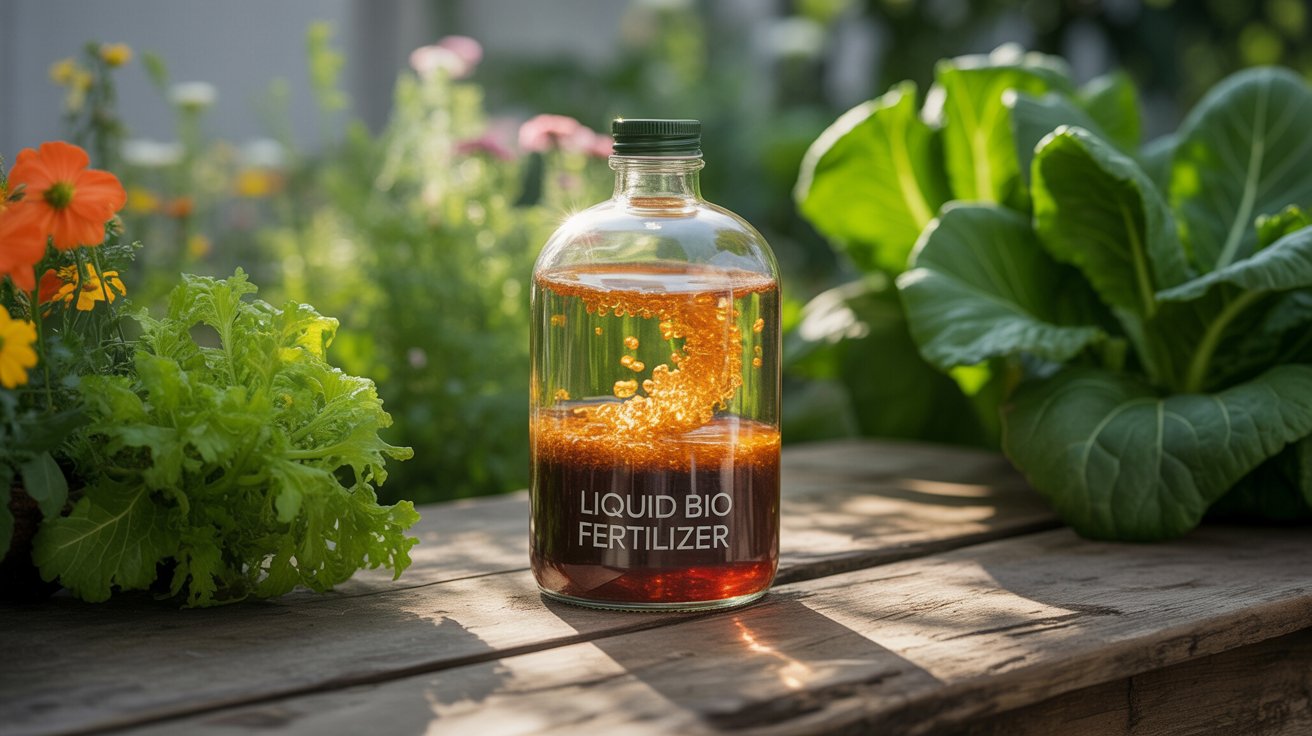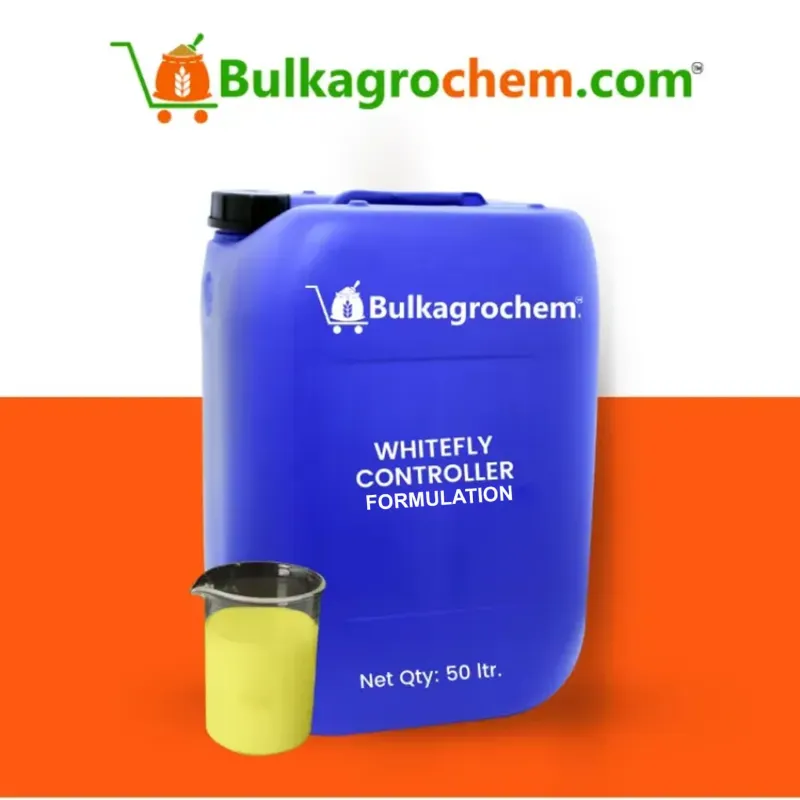Liquid bio fertilizer is a living nutrient-dense solution of beneficial soil microbes that naturally fix nitrogen, release phosphorus, and mobilize potassium for crops.
With an excess of Rhizobium, Azotobacter, P-solubilizing Bacillus, and growth-promoting enzymes contained within, each millilitre delivers a consistently balanced organic nutrition.
Microbial processes are working together with root biochemical processes so that plants absorb nutrients efficiently, while soil acquires long-term structure and vitality—making liquid bio fertilizer a natural, softer, yet impactful substitute for dangerous chemical inputs.
Whether through seed treatment or foliar spray, each drop enables resilient, high-yield farming, and can be the first of many steps towards a more sustainably, flourishing form of food production.
Introduction: What is Liquid Bio Fertilizer? Definition & Importance
A living solution teeming with beneficial bacteria and fungi that are introduced to plant roots to provide direct nutrition. Replaces, reduces or eliminates chemicals as well as input costs, while keeping soils alive.
Liquid Biofertilizer Basics – Organic Farming Cornerstone
Brewed using naturally occurring microbes: Rhizobium, Azotobacter and various Bacillus strains. Functions well with compost, manure and green manures.
Why Liquid Form Matters – Faster Microbial Colonization
Microbes are “woken up” by the moment they encounter moist soil - they stay suspended in a nutrient broth. Convenient for applying with drippers, as foliar, or soaking seeds- really doesn't require bulky carriers.
Even Product Coverage = Uniform Root Colonization = Faster Results in the Field.
The Science Behind Liquid Biofertilizer: How It Works
NPK Liquid Bio Fertilizer formulations fix nitrogen, release bound phosphorus, and mobilize potassium all in one pass.
Organic acids, enzymes, and natural hormones help promote root architecture and drought tolerance.
Microbial Mechanisms – Nitrogen Fixation & P/K Solubilization
Rhizobium Liquid Biofertilizer forms nodules on legume roots, pumping free atmospheric nitrogen into a plant-ready form.
Phosphate solubilizing Bacillus secretes acids that release locked P, while silicate bacteria release K available in soil. Result: balanced nutrition without synthetic salts.
Nutrient Absorption & Root Symbiosis
Rhizobium Liquid Biofertilizer forms nodules on legume roots, pumping free atmospheric nitrogen into a plant-ready form.
Phosphate solubilizing Bacillus secretes acids that release locked P, while silicate bacteria release K available in soil. Result: balanced nutrition without synthetic salts.
Key Benefits of Liquid Biofertilizer in Sustainable Farming
Improved Soil Health – More Organic Matter & Biodiversity
Liquid biofertilizer provides live microbes that convert crop and residue into humus, increasing organic matter levels, season after season.
Beneficial bacteria and fungi out-compete pathogens, which enhances soil biodiversity and promotes natural disease suppression.
Healthier soil structure increases water infiltration and with it aeration - important for stronger, deeper roots.
Higher Yield, Lower Input Cost – Long-Term ROI
Field trials have evidence of an increase of 8-20% if the microbiome enriched NPK liquid bio fertilizer is included in an integrated nutrient plan due in part from nitrogen fixation, phosphorus unlocking, and potassium mobilization.
Lowering reliance on synthetic NPK means lower input bills and additional fuel costs to apply these synthetic inputs.
Differentiating Chemical Fertilizers vs Organic Liquid Biofertilizer
Environmental Impact Comparison – Run-off & Emissions
A standard chemical NPK salts fertilizer is very leaky, so that nitrate-nitrogen, and nitrous oxide, which warms the planet, can escape.
Liquid biofertilizer (like Terra Organics' organic bio fertilizer) releases nutrients slowly through microbial processes, and can reduce leaching losses by about 50 % and greenhouse gases dramatically.
Natural Nutrient Sources vs Synthetics
NPK liquid biofertilizer reduces the reliance on manufactured "fertiliser" inputs, allowing crops to use nutrients on-demand, as it enables microbes to access native soil nutrients via solubilization P and K that was previously bound, and fixing N from the atmosphere.
Synthetics give you a quick Ethernet "hit" but is lost before roots can use it and have salt deteriorating effects on soil biology.
Long term studies on bio-waste have demonstrated more organic matter and more earthworms in the soil, when biofertilizers replaced part of chemical fertiliser inputs.
Choosing the Right Liquid Biofertilizer — NPK Liquid Bio Fertilizer vs Rhizobium Liquid Biofertilizer
NPK Liquid Bio Fertilizer – The Balanced Macro-Nutrient Booster
A liquid biofertilizer matrix of specialist microbes that fix N, unlock P, and mobilize K with one pass.
Ideal for cereal, vegetable crops, and fruit orchards where a blanket nutrient application is needed.
It provides food to plants gradually without the salt shock from chemicals and increases soil health over time.
Rhizobium Liquid Biofertilizer – The Legume-Specific Nitrogen Partner
Custom strains of Rhizobium liquid biofertilizer establish in legume roots and form nodules, which then fix free atmospheric nitrogen into plant-available form.
Well-suited for soybeans, chickpeas, groundnuts, and cover-crop clover, it provides nitrogen to increase protein levels and leave behind residual N for the next rotation.
Helps to cut synthetic urea use by up to 50 %, which cuts greenhouse-gas emissions and production costs.
Match Product to Crop & Soil – pH, Texture, Climate Factors
What is Liquid Bio Fertilizer? Begin with soil pH and nutrient status, Generally acidic soils will need P-solubilizers whereas sandy soils will need K-mobilizers.
Hot, dry zone soils will benefit from Drought tolerant Bacillus consortia; cold, wet climates will benefit from Azotobacter rich formulations.
Remember to always check liquid products for viable cell counts (CFU /mL) and compatibility with current fertigation systems to maximize performance in the field.
Application Best Practices for Liquid Biofertilizers
Dosage & Dilution Guidelines – Get the Ratios Right
- For most crops, you can dilute liquid biofertilizer with water at a ratio of 1 : 50 - 1 : 100 (product : water).
- Seed soak: 5 mL biofertilizer per kg of seed; allow 30 minutes drying time before sowing.
- Soil drench or drip: Apply 2-3 L of NPK liquid bio fertilizer per acre of crop, divided between the vegetative and flowering stages.
- Foliar spray: For a quick microbial boost spray 1 L in 100 L water at the start of bloom.
Compatibility & Storage Tips – pH, Temperature, Shelf Life
- Keep your spray-tank pH between 6.0 - 7.5; to prevent chemical shock, always add biofertilizer last.
- Do not mix live cultures with copper fungicides or use high-salt fertilizers in the same tank.
- For best results store unopened bottles at 15 - 25 °C. Refrigeration (not freezing) can prolong shelf-life for up to 12 months.
- Shake well before usage - live microbes in a liquid biofertilizer resuspend for optimal viability.
Future Trends in NPK & Rhizobium Liquid Biofertilizer Technology
Nano-Formulations & Encapsulation – Longer Shelf Life, Faster Uptake (Graphic)
- Advances in laboratories are enabling microbes to be wrapped in nano-silica or alginate beads, protecting them from heat and UV and ensuring the unopened life of any liquid biofertilizer is extended to 24 months.
- Upon contact with root exudates, the nano-containing carrier bursts to release a micro-dose of nutrients plus live cells right where you wanted them!
- Look for next-gen NPK liquid bio fertilizer to be packaged as a concentrated nano-gel, where one trailer load will treat the same acreage as three trailers today.
Precision Fertigation & IoT Monitoring – Data-Driven Dosing
Smart drip lines currently inject rhizobium liquid biofertilizer directly into the soil during maximum nodulation windows, based solely on soil moisture and temperature sensors.
Cloud-based dashboards will answer the farmer's timeless questions "What is Liquid Bio Fertilizer doing right this minute?" - showing real-time CFU counts, pH, and flow rates.
Outcomes: 15% higher nitrogen fixation efficiency and 20 % less water use, all validated using real-time data.
FAQs
Q1. What is the shelf life of liquid biofertilizers?
When users ask "What is Liquid Bio Fertilizer?", they learn that a properly sealed liquid biofertilizer can remain ≥80 % viable for 12-18 months when stored cool, dark, and undiluted.
Q2. Can I mix liquid biofertilizer with chemical fertilizers?
Yes, NPK liquid bio fertilizer can tank-mix with mild chemical nutrients after a jar test. Keep in mind to not use high salt or copper products that will kill microbes.
Q3. How soon will I see results after application?
Most growers see stronger roots and greener leaves from a liquid biofertilizer within 10-15 days, and measurable yield benefit by harvest.
Q4. Are liquid biofertilizers allowed under organic certification
Certified-organic rules allow rhizobium liquid biofertilizer and other microbial products as long as no synthetic additives or GMO strains are present.
Q5. Do they work in all soil types and climates?
Liquid biofertilizers work on sandy, loamy, and clay soils from arid tropics to cool temperate regions, but strains and rates should correspond with local pH and temperature.
Q6. How should liquid biofertilizer be stored on-farm?
Store liquid biofertilizer in its original opaque bottle at 15-25 °C. Shake gently before using. Do not freeze, use in direct sunlight, and do not store it with pesticides.
Q7. Is there any risk of over-application?
Since NPK liquid bio fertilizer is rarely harmful to crops, it is a bit more money spent than you needed to, the only concern is a risk of short-term bio-film blockage in drip lines.
Conclusion: Make the Switch to Liquid Biofertilizers for a Healthier Planet and Profitable Harvests
Key Takeaways – Why It Matters
“To even ask, What is Liquid Bio Fertilizer? is to access a climate-smart input that boosts yields while regenerating soil life. Crop data shows that a carefully chosen liquid biofertilizer can reduce nitrogen phosphorus and potassium (NPK) use by 25-50 % with performance that is not compromised at all.
Next-Gen Farming Starts Today
Every season you put your plan into action today by using sensor-controlled dosing, nano-encapsulated blends, and AI-formed consortia. Every season you run healthy soils will bring you higher profits.




